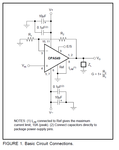hshah8970
Full Member level 2

Hello everyone!
I've made a simple voltage follower using OPA549 and it isn't working. I've applied +18V and -18V as the +V and -V supply voltages. The input voltage I apply is in the range from 3V to 7V. The problem is that the output voltage drastically drops as soon as I apply the load to the buffer. The load is a DC motor that starts when the voltage following circuit is turned on; but then the output voltage of the followers wanes and the motor is brought to a halt after .
I'm confused. The voltage follower is supposed to eliminate the loading effect and it fails to do so.
Please help! Thank you.
P.S. By a 'simple voltage follower' I am referring to this circuit: http://hades.mech.northwestern.edu/images/b/b5/Opamp_voltage_follower.gif
Also, in case this is relevant, the output current utilized by the motor is under 5A.
I've made a simple voltage follower using OPA549 and it isn't working. I've applied +18V and -18V as the +V and -V supply voltages. The input voltage I apply is in the range from 3V to 7V. The problem is that the output voltage drastically drops as soon as I apply the load to the buffer. The load is a DC motor that starts when the voltage following circuit is turned on; but then the output voltage of the followers wanes and the motor is brought to a halt after .
I'm confused. The voltage follower is supposed to eliminate the loading effect and it fails to do so.
Please help! Thank you.
P.S. By a 'simple voltage follower' I am referring to this circuit: http://hades.mech.northwestern.edu/images/b/b5/Opamp_voltage_follower.gif
Also, in case this is relevant, the output current utilized by the motor is under 5A.




